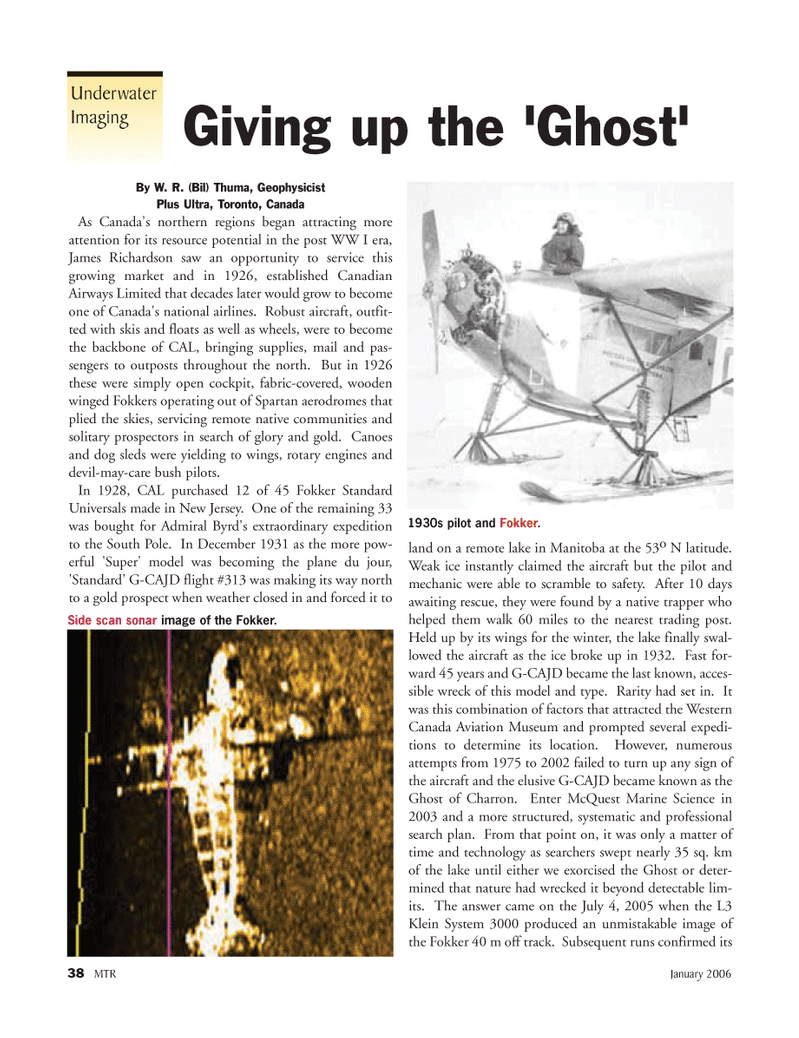
Page 38: of Marine Technology Magazine (January 2006)
Marine Science Institutions
Read this page in Pdf, Flash or Html5 edition of January 2006 Marine Technology Magazine
38 MTR January 2006
By W. R. (Bil) Thuma, Geophysicist
Plus Ultra, Toronto, Canada
As Canada's northern regions began attracting more attention for its resource potential in the post WW I era,
James Richardson saw an opportunity to service this growing market and in 1926, established Canadian
Airways Limited that decades later would grow to become one of Canada's national airlines. Robust aircraft, outfit- ted with skis and floats as well as wheels, were to become the backbone of CAL, bringing supplies, mail and pas- sengers to outposts throughout the north. But in 1926 these were simply open cockpit, fabric-covered, wooden winged Fokkers operating out of Spartan aerodromes that plied the skies, servicing remote native communities and solitary prospectors in search of glory and gold. Canoes and dog sleds were yielding to wings, rotary engines and devil-may-care bush pilots.
In 1928, CAL purchased 12 of 45 Fokker Standard
Universals made in New Jersey. One of the remaining 33 was bought for Admiral Byrd's extraordinary expedition to the South Pole. In December 1931 as the more pow- erful 'Super' model was becoming the plane du jour, 'Standard' G-CAJD flight #313 was making its way north to a gold prospect when weather closed in and forced it to land on a remote lake in Manitoba at the 53 o
N latitude.
Weak ice instantly claimed the aircraft but the pilot and mechanic were able to scramble to safety. After 10 days awaiting rescue, they were found by a native trapper who helped them walk 60 miles to the nearest trading post.
Held up by its wings for the winter, the lake finally swal- lowed the aircraft as the ice broke up in 1932. Fast for- ward 45 years and G-CAJD became the last known, acces- sible wreck of this model and type. Rarity had set in. It was this combination of factors that attracted the Western
Canada Aviation Museum and prompted several expedi- tions to determine its location. However, numerous attempts from 1975 to 2002 failed to turn up any sign of the aircraft and the elusive G-CAJD became known as the
Ghost of Charron. Enter McQuest Marine Science in 2003 and a more structured, systematic and professional search plan. From that point on, it was only a matter of time and technology as searchers swept nearly 35 sq. km of the lake until either we exorcised the Ghost or deter- mined that nature had wrecked it beyond detectable lim- its. The answer came on the July 4, 2005 when the L3
Klein System 3000 produced an unmistakable image of the Fokker 40 m off track. Subsequent runs confirmed its
Underwater
Imaging
Giving up the 'Ghost' 1930s pilot and Fokker.
Side scan sonar image of the Fokker.
MTR#1 (33-48).qxd 1/9/2006 3:33 PM Page 38

 37
37

 39
39
